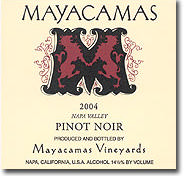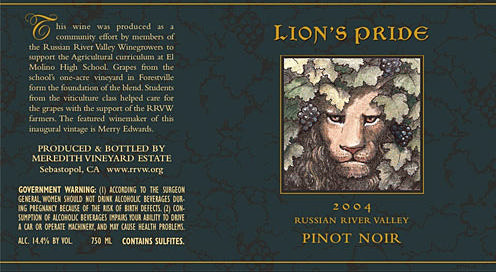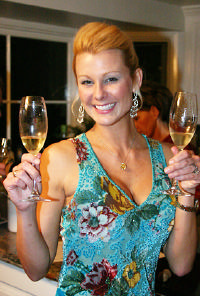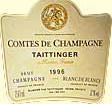PinotFile: 6.8 December 10, 2006
|
Mayacamas Pinot NoirMayacamas Vineyards is one of California’s heritage wineries. Known for its longlived Chardonnays and Cabernets, Mayacamas was one of the original artisan wineries and developed quite a cult following beginning in the 1970s. The Mayacamas Mountains that divide the Napa and Sonoma Valleys were originally the home of the Wappo Indians who were stone age hunters. The first white settlers came to the future site of Mayacamas Vineyards on Mt. Veeder in the 1860s and built a barn which still stands. Years later, a German immigrant and pickle merchant in San Francisco, John Henry Fisher, planted a vineyard and built a stone winery here The winery had multiple uses including a summer home for his family and a ranch to raise and care for the horses he used to deliver pickles to his clients in San Francisco. His wines were loaded into barrels, driven by horsedrawn wagons 15 miles to the Napa River, and put onto ferry boats for the trip to San Francisco where the wine was bottled and sold. In the early 1900s, the Fishers declared bankruptcy and the winery quickly fell into disrepair. In 1941, Jack and Mary Taylor purchased the land, restored and lived in the old stone winery, and renamed the estate, Mayacamas Vineyards. The current owners, Robert and Elinor Travers, purchased the winery in 1968. They enlarged and improved the aging facilities, purchased adjacent land, and planted and replanted vineyards. Under their direction, the winery became famous for it’s rich and tannic mountain-grown Cabernets. Today, there are 53 acres of vineyards planted on mountain slopes ranging from 1,800 to 2,400 feet above sea level. Production is about 2,000 cases of Cabernet Sauvignon (blended with a little Merlot and Cabernet Franc), 2,000 cases of Chardonnay, 600 cases of Sauvignon Blanc, and a small amount of Pinot Noir. The location yields small crops (less than a ton per acre) and small grapes resulting in wines of intense flavor and character. The winemaking style is intended to make wines that are not always flattering when young and benefit from aging, an old-fashioned concept in today’s instant gratification world. An insightful interview with Bob Travers by Alan Goldfarb was posted on Appellation America (www.appellationamerica.com) November 15, 2006. Travers calls himself a traditionalist who shuns high-alcohol wines. “The highest and best use of wine is with food. When they finally get there (mature), they (my wines) have a depth of character that high-alcohol wines don’t have.” Travers is one of the last in the Napa Valley to release his wines and notes, “It’s always been my belief, and my findings have confirmed this, that the wines I like the best are also the ones that take substantially longer to age and mature. If they do live a long time, they develop different characteristics. If you have a good vineyard, its best to take it slow.” Wine writer, Matt Kramer, is a big fan of Mayacamas wines, citing their ability to “convey a sense of somewhereness,” and “profound expressions of high-elevation Mount Veeder place.” He continues, “Really, you can’t do better than Mayacamas Vineyards for California wine profoundness.” I must confess that I have never drank a Mayacamas Pinot Noir. In James Laube’s book, California Wine, he derides Mayacamas Pinot Noirs, saying the Pinot Noirs are “very light and herbal in style.” Based on my singular experience described below, I could not disagree more.
 2004 Mayacamas Vineyards Napa Valley Pinot Noir 14.5% alc., approx 200 cases, $32, Winemaking at Mayacamas is unique for Pinot Noir. Fermentation lasts two weeks at 72-75 degrees. The wine is racked several times while aging for its first half year in 1000 gallon American oak casks, then spends a year in 60 gallon French oak barrels. Only 10% new oak is used and after the barrels are five years old, Travers shaves out the insides. The wine is bottled at 18-20 months of age and usually released for sale when four years old. Travers recommends savoring his Pinot Noirs between 7 and 12 years. The 2004 vintage was drinking well early so it was released in September, 2006. · This Pinot Noir is medium in body with a dark ruby color. The nose is alluring with dark fruits, herbs and anise. On the palate, there is a complex array of ripe Pinot fruits enhanced by plentiful earthy mushrooms. The texture is rich. The persistent finish reveals an attractive touch of oak and dusty tannins. A heady Pinot Noir with great charisma.
Mayacamas Vineyards is located at 1155 Lokoya Rd, Napa, CA 94558. The phone is 707-224-4030 and the website is www.mayacamas.com. There is a mailing list for the semi-annual newsletter. Visitors are welcomed Monday through Friday by appointment.
Churchill CellarsKen and Susan Churchill are Pinot Noir enthusiasts who sold their environmental consulting business and moved to the Russian River Valley to make ultra-premium Pinot Noir. Their first Pinot Noir, the 2003 Churchill Cellars Bella Luna Vineyard Pinot Noir, won a Gold Medal at the 2006 San Francisco Chronicle Wine Competition. Inspired by their success, they are now pursuing their dream in earnest. They are committed to sustainable and precision farming and have talented winemaker, Anthony Austin, on board to steer the ship. Anthony Austin crafted some memorable Pinot Noirs in the early days of Santa Barbara County wine history and is also currently the winemaker at Sonoma Coast Vineyards. Winemaking is typical for California Pinot Noir. The grapes are de-stemmed and cold soaked for 9 days. Punch downs are done twice a day. The fruit is fermented with both natural and Assmanhausen yeast. The grapes are then pressed and placed in new French oak barrels for 18 months. The estate vineyard, Bella Luna Vineyard, is located on the Churchill Estate in the Russian River Valley. Soils are sandy loam and clonal selections are Dijon 115, 667, 777, and 459.. The vineyard is planted with 4’ x 4’ spacing, similar to Burgundy. Watering is kept to a minimum to mildly stress the vines and concentrate the flavors in the grapes.
2004 Churchill Cellars Russian River Valley Blend Pinot Noir 14.1% alc., 479 cases, $36. This wine is a blend of six Russian River Valley and Sonoma Coast vineyards. Clones are Dijon 115, 667, 777, Swan and Pommard 3. 25% whole clusters are added in. Aged in 50% new Tonnellerie Sirugue oak barrels and 50% seasoned barrels. · This is a medium to fullbodied Pinot Noir with a deep, ruby color. Aromas of damp leaves and dark stone fruits lead to fruit-driven flavors. The wine is tight and concentrated at this stage, and although it is fat on the palate, it lacks acidity. As it warms, the nose and finish deliver a little heat.
2004 Churchill Cellars Bella Luna Russian River Valley Pinot Noir 14.5% alc., 124 cases, $45. 15-18% whole clusters. Aging and winemaking the same as above. · The aromatics in this wine are to die for: ripe cherries, vanilla, and Xmas spice. Tasted over a few hours, the wine kept pumping out these terrific aromas and I was thoroughly content just to sniff. It was a nose you could drink. I am convinced that this type of perfume is distinctive and typical of great Russian River Valley Pinot Noirs. The wine is full-bodied and rich with red and black fruits and tea flavors, but the nose trumps the flavors at this point. The mouth feel is luxurious. A slight astringency at the finish will flush out with cellaring. This vineyard is a star in the making and in the same mold as its neighboring prestigious vineyards such as Olivet Lane and Olivet Grange.
Churchill Cellars is located at 1574 Olivet Rd, Santa Rosa, CA 95401. The phone number is 707-578- 5393. Wine may be purchased on the website at www.churchill-cellars.com.
Lion’s Pride RRV Pinot NoirThe Russian River Valley Winegrowers Foundation (RRVWF) have collaborated with El Molino High School to make and market the inaugural Pinot Noir from the school’s one-acre vineyard in Forestville. The winemaking was directed by Merry Edwards who was assisted by the viticulture students at El Molino High School. Grapes were harvested in 2004 and crushed at Taft Street Winery. Only 6 barrels of this wine were made. Half of the proceeds of the sale of the Pinot Noir will go to the agriculture and viticulture program at El Molino High School to help educate future vintners and growers. A good cause and a good Pinot Noir.  The wine may be reserved at $275 half case or $500 full case through the website: www.rrvw.org or email at info@rrvw.org. Wine pick up and payment are only allowed between 2/30/07 and 3/20/07.
The Magic of Old BurgundiesDrinking aged Pinot is a completely different experience than imbibing recent vintages. The primary fruit aromas give way to the smells that fine wine acquires over time, known as the bouquet (or to the chemist, ’reductive bouquet’). After many years in the bottle, old wines develop smells of truffles, fungi and mushroom. There are often other olfactory charms as well, including loamy earth, sweaty leather, old library book, garbage, mahogany, smoked bacon, rust and iron, musk, tobacco smoke and so forth. Not everyone finds charm in an older wine’s bouquet, but zealous fans find it magical. The flavors of Pinot Noirs that have aged take on secondary characteristics. Notable among these are beef bouillon, anise, pencil shavings, Chinese five spice, mushrooms on a grill, beef stew, molasses, fig, Worcestershire, sherry, vitamin tension, smoke, and even foxy and fecal highlights. The development of secondary flavors tends to obscure the features of the wine which delineate its origin or terroir, although experienced tasters can still make pronouncements that are relevant to the sense of place of the wine. When it comes to older Burgundies, there is no definitive rating or judgment. The wines simply represent snapshots frozen in time and memories that follow. There is considerable bottle variation, so part of the charm of drinking old wines is the anticipation upon popping the cork. You just never know what you are going to get. Knowing provenance of the wine is of course preferred, but this is often shrouded in the many years that have transpired. In older Burgundies there is always the scepter of poor wine transport and storage. The use of temperature-controlled containers to ship French wine to the United States wasn’t popularized by California wine importer Kermit Lynch and others until the mid-1970s. A small crew gathered recently at Napa Rose Restaurant in Anaheim, California to drink some old Burgundies. There was some discussion prior to the event on how the wines should be drunk and whether decanting was appropriate. One attendee was told (incorrectly I believe) that the corks should be popped several hours before drinking, allowing “micro-oxygenation” of the wine therein and bringing out the full charm of the wine. According to Emile Peynaud writing in his classic treatise on wine tasting, The Taste of Wine, he strongly recommends tasting very old bottles immediately after the cork has been drawn. “It is definitely incorrect to decant old wines (wherever they come from) several hours before they are drunk because, following even a light aeration, their bouquet, fruit of the reduction process slowly achieved in the absence of air, weakens with varying rapidity, depending on the wine.” We chose to following this path and opened each wine in succession, from oldest to youngest, drinking each wine immediately after it was opened.
1990 Pousse d’Or Volnay 1er Les Caillerts Clos Des 60 Ouvres Monopole This wine really starred. It had the most body, structure and appeal of all of the wines. With air, the bouquet featured herbs, spearmint, and mushrooms. The texture was mouth coating and silky. Tannins were moderate and the finish was fruity and alive, still with bright strawberry and cherry flavors.
1983 Haegelen-Jayer Clos de Vougeot Quite a nice drink from a poorly-regarded vintage in Burgundy. The color was light but still violet. The nose had attractive cherry and spice but faded quickly. There were tart cherry and cranberry fruits evident along with cured meat notes. The wine had crisp acidity and paired nicely with food. A surprise. Alfred Haegelen is married to Madeleine, a niece of the great Henri Jayer.
1978 Camille Giroud Gevrey-Chambertain 1er Les Cazetiers This was a decent wine but no one was ga-ga over it. It was simple and balanced but not exciting. The best feature was a sweet spicy finish. It still had fine tannins and probably could last awhile, but there would be no point to aging it further.
1947 Justerini & Brooks Clos de Vougeot Maderized and undrinkable. The term maderized refers to wines that have turned deep yellow or brown in color and are dried out on the palate. Only one in the group was brave enough to taste the wine, but he could discover no redeeming qualities in it.
1946 Domaine des Lambrays Clos des Lambray Grand Cru Classe Now this was old Burgundy. The nose was all feral, fecal and fungal and quite nice. The fruit had completely dissipated and the finish was notably metallic. The food (oxtail ravioli) seemed to perk it up. Nothing extraordinary, but fun to drink nonetheless. An historical note: this vineyard did not officially became a Grand Cru until 1981.
1945 Leon Violland Beaune 1er La Montée Rouge This wine was surprisingly fresh and dark-colored. It was clear to every taster that this wine benefited from the old Burgundy practice of adding Grenache or other similar hardy red varietal from the Rhone or Algeria to Pinot Noir to provide body and color to the wine. This wine looked and smelled Rhone and had none of the secondary charms of an aged Pinot Noir. The cork was black and appeared authentic, and if the wine was really over 60 years, it had remarkable grip and persistence.
Purchasing older Burgundies at auction or retail is a bit of a crap shoot because of provenance. Prices also have gone stratospheric, particularly for bottlings from stellar vintages and wines made prior to 1978. The best strategy is to avoid the designer names such as Jayer, Roumier, and Leroy, and concentrate on reliable producers with less cache such as Mortet, La Farge, Montille, Barthod, Trapet and so on. Remember that vintage is all important and look to recent vintages like 1978, 1985, 1988, 1990, 1993, 1995, and 1996. Off vintages can surprise from good producers as the 1983 wine showed above. When it comes to old Burgundies, “It’s not the Pinot in my life, it’s the life in my Pinot.”
Minerality: Fact or FictionI have never really thought that much about minerality in Pinot Noir, usually associating minerality with higher-acid white wines such as Chablis and German Rieslings. Recently, there has been some ribald discussion at wine tastings, as well as on the internet, about minerality. The central issue seems to be whether minerals in vineyard soils can actually travel up the roots and xylem into the grapes and survive fermentation in large enough concentrations to produce identifiable mineral flavors (for example, flint or slate). Many smart wine people believe this does not happen. They believe the so-called minerality in wine really originates from acidity and sulfur-based compounds that develop in the winemaking process. Tim Patterson recently wrote an excellent article in Wines & Vines (“Myths of Minerality,” December, 2006) in which he reviewed the limited research on the minerality of wine and offered his own opinions on its origins. He points out that there is no “mineral” on the Wine Aroma Wheel and the creator of the wheel, Dr. Ann Noble, feels that “Minerality is a concept which could never be consistently defined in words or physical standards.” Or as she put it more bluntly, “Sucking on stones doesn’t give any sensation akin to wine flavor.” University of California Davis flavor chemist, Dr. Sue Ebeler said, “There are no clear correlations of any specific compounds with a ‘mineral’ aroma. It is likely a complex mixture of compounds which we associate with the smell of soils or rocky area.” Patterson points out that minerals such as potassium, magnesium, sodium and calcium are present in wine as salts of mineral acids, but are in such small concentrations they do not significantly influence wine flavors and aromas. More likely, as noted by Jamie Goode (The Science of Wine), sulfur-based compounds associated with reductive winemaking or nutrient stress in yeast during fermentation contribute to what is called minerality. Support for this hypothesis comes from Germany, known for high acid wines, reductive winemaking and nutrient deficiencies in wine musts, where many of the wines are described as sharp, acidic, and highly mineral.
Time of the Year for ChampagneThe end of the year is often the time where thoughts turn to Champagne. Whether it be sitting watching a football game with a good blanc de blancs snacking on potato chips or buttered popcorn, or celebrating the New Year with a special prestige cuvee, Champagne is the wine of the season. Champagne is unique among French wines in that it is named after the houses or marques that produce them. Styles can vary depending on the grape makeup. Blanc de blancs are made entirely from white grapes, specifically Chardonnay. Blanc de noirs are made entirely from dark grapes, either Pinot Noir and/or Pinot Meunier. Rosés are made from blending in some red wine or by a small amount of red grape skin contact. Most Champagne is a blend of Chardonnay, Pinot Noir, and Pinot Meunier in varying amounts, each of which has been fermented separately. Brut refers to a dry Champagne with 1.5% residual sugar; Demi-sec is medium-dry with 3.3%-5% residual sugar. Champagne is full of lore and here are a few bits of trivia you can use over the holidays to impress your friends. Epernay was burned, sacked, or pillaged at least twenty-five times in the thousand years before the 17th century. Napoleon fought his last battles in Champagne. The day before Epernay fell to Russian and Prussian troops in 1814, Napoleon bestowed his own cross of the Legion of Honor on the mayor of the city, Mean-Remy Moet. Then he left for Paris and abdicated the throne. The term “beheading,” which dates from the time of Napoleon, refers to the way Napoleon’s officers opened Champagne bottles with their sabers. Moet & Chandon is the largest Champagne house, with 90 million bottles of wine aging in its cellars at any given time. Ruinart is the oldest Champagne house, dating to 1729. The pressure in a bottle of Champagne is 90 pounds per square inch, about three times that in an auto tire. The speed of a popped Champagne cork has been estimated at anywhere from 35- 100 miles per hour when it leaves the bottle. For reading on Champagne, I recommend the following three books: Champagne. How the World’s Most Glamorous Wine Triumphed Over War and Hard Times, written by Don & Petie Kladstrup (William Morrow, 2005, $24). 4000 Champagnes, written by Richard Juhlin (Flammarion, 2005, $40). Uncorked: The Science of Champagne authored by Gerard Liger-Belair (Princeton University Press, 2004, $15).  An impressive lineup of Champagnes was tasted on December 11, 2006. I am omitting detailed tasting notes as the event was rather informal in an afternoon of social conviviality. I think the value here is noting the top wines chosen by a consensus of the twenty members of the group. This can be used as a guide in your future purchases. Favorites are listed by ranking in red. 1985 René Collard Cuvee Speciale Rosé Brut (#3) 1988 Fleury Pére et Fils Siécle d’Or (#5) 1990 Le Grand Dame 1990 Perrier-Jouet Fleur de Champagne Brut 1990 Drappier Grande Sendrée Brut (corked) 1995 Charles Heidsieck Blanc des Millenaires Brut 1995 Nicolas Feuillette Millésimé Cuvée Spéciale Brut 1996 Jean Laurent Millésimé Brut 1996 Lenoble Grand Cru Blanc de Blancs 1996 Duval Leroy Brut (#2, $40) 1996 Laurent Perrier Brut 1996 Le Grand Dame (#4, $110) 1996 Henri Abele Millésimé Brut Reserve 1996 Lean Laurent Blanc de Blanc Millésimé 1996 Nicolas Feuillette Cuvee Palmes D’Or 1996 Comte Adoin de Dampierre Grand Vintage Brut 1996 Taittinger Comtes de Champagne Blanc de Blancs (#1, $110)  Taittinger was established as a company in 1734 by Jacques Fourneaux. After World War I, the company moved to the 13th century historical residence located on Rue de Tambour known as “The House of the Counts of Champagne.” In 1932, Pierre Taittinger acquired the great residence. He decided that Chardonnay was to be the dominant grape for the brand. Along with his two brothers, Jean and Claude, they oversaw a period of remarkable growth and began operation in the cellars of the 13th century Saint-Nicaise Abbey in Reims where the 1996 Taittinger Comtes De Champagne was produced. Today Champagne Taittinger has acquired the status of Grande Marque house. 1996 was a remarkable year for Champagne. Records indicate you must go back to 1928 to find a potential alcohol-acidity combination of this level and of this quality. Comtes De Champagne is only produced when all of the conditions, essential to its unique style, are met including: * The harvest must be of exceptional quality and worthy of vintage Champagne * It is made exclusively from Chardonnay grapes (100% Grands Crus) from the most renowned vineyards of the Cote des Blancs. * Only wines from the first pressing (La Cuvée) are used. * 5% of the wines used in the blend are aged in new oak barrels.  The second place Champagne, the 1996 Duval-Leroy Brut, is a terrific value ($40). The Wine Spectator rated many of the newest Duval-Leroy releases very highly when tasted against some of the Grand Marques. Duval-Leroy is under the direction of Carol Duval-Leroy who took over as president upon the death of her husband in 1991. The house currently has 175 hectares of vineyards with presence in all villages of the Cote des Blancs with classified Grand Cru vineyards. The 1996 Brut is 65% Chardonnay and 35% Pinot Noir.
James Bond and ChampagneJames Bond had a thing for fine Champagne. See if you can match the Champagne with the movie(s).
1 Taittinger Brut Blanc de Blancs 1943 2 Veuve Cliquot Rosé 3 Bollinger 4 Dom Perignon 1946 5 Krug Champagne
1 Casino Royale, On Her Majesty’s Secret Service 2 Diamonds are Forever, Thunderball 3 Diamonds are Forever 4 Moonraker 5 On Her Majesty’s Secret Service
Wine Terms from the Urban Slang DictionaryWine candy: another name for Jolly Ranchers. Wine spritzer: when you pee a little under your undies, usually from laughter. Wine rack: a young female, who while currently unimbibable, will within a matter of years be ripe for the ‘plucking.’ Winegasm: that feeling of euphoric glee at finding a bottle of wine that is being sought for special brand name, vintage, or even price. Wine spodiodie: from the song, “Drinkin’ wine spode-o-dee” by Jerry Lee Lewis and others. A shot that has a layer of Port on the bottom, then a layer of cheap bourbon, finished on top by another layer of Port. Wine-puss: one who constantly whines. Wine: a form of dance, involves gyration of hips, performed to mainly West Indian music like reggae, calypso. Cork dork: a person who talks about wine too seriously. Merlot sippers: intellectually lazy, college-educated adults who entertain each other with pseudo-intellectual banter. Merloment: a minute portion of time where your judgment was affected by the consumption of too much wine. MerJoe: pronounced “Merlot” - a cheap wine one would get at Trader Joe’s supermarket. |